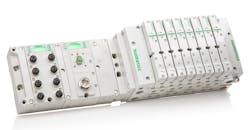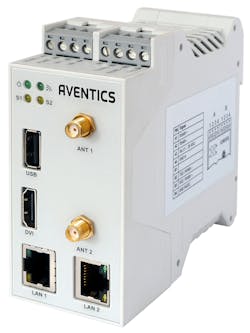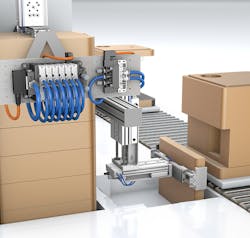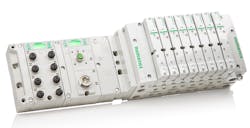One of the key developments associated with the emergence of the Industrial Internet of Things (IIoT) and Industry 4.0 is the expanding use of sensors throughout automation systems, including pneumatic components. Sensors have become smaller, more lightweight, and easier to use in various pneumatic components, allowing measurement of temperatures, pressures, flow rates, cycle times, valve response rates, and so on. Even the simplest devices can provide crucial information at some point.
Machine builders in many industries are responding to IIoT’s growth by adding data gathering sensors to their equipment, with the resulting data made available for analysis and, as systems become more advanced, converted into actionable information. Manufacturers are finding that IIoT is less a revolution than a gradual evolution toward smart components, machines, and systems that has been taking place over the past few years.
In fact, pneumatics is already established as an advanced technology that lends itself well to these new capabilities, giving companies a deeper understand of their equipment’s actual operational performance. For example, OEMs can use pneumatic capabilities to monitor a pneumatic system’s operating state, analyze that data, and report on its operation, resources used, energy efficiency, and much more. The same sensors can also provide reliable information on actuators, valves, and other devices without involving the machine controller.
In addition, machine builders can leverage IIoT capabilities to improve pneumatic components’ extensive diagnostic abilities to measure critical parameters including like cylinder velocity. This provides predictive maintenance information to prevent unplanned downtime.
A smart pneumatics monitor module, this one from Aventics, provides users with reliable information on the state of wear of pneumatic actuators, valves, and other devices, as well as the energy efficiency of pneumatic systems.
Pneumatics IIoT advantages
Pneumatics offers several key benefits in an IIoT environment, including:
Predictive maintenance. Maintenance is where pneumatic IIoT capabilities truly shine. After all, wear-and-tear is a fact of life in any industrial setting. Predictive and preventive maintenance programs are essential to efficiently manage equipment life cycles and maximize the overall equipment effectiveness (OEE) and thus increase return on investment. By using appropriate data from IIoT sensors’ analyzed data, for example, technicians can predict that a shock absorber at the end of an actuator is deteriorating by noting an increase in its stroke speed, even if only by a few milliseconds. Knowing which equipment needs maintenance, plant personnel can replace defective or aged-out components with shorter and fewer unplanned machine stoppages.
Safety. Pneumatics already encompasses several safety features and components to protect operators and equipment, prevent downtime, improve reliability, and extend operational life. With IIoT, pneumatics is using new capabilities in tracking and measurement. These provide great insight into machine operation and component and subsystem performance.
With these insights comes a richer opportunity to monitor machine safety and better protect people and equipment from harm. For example, suppose a machine had a safety light curtain controlling a valve and the valve’s response time changes from 30 msec to 50, or even 70 msec, before the valve reached the end of its replacement cycle. This could pose a safety hazard because it would let an operator get much further into the dangerous portion of a machine’s lifecycle before a safety response could be made. That decline in the valve response time (and the corresponding alert response time) is the kind of useful safety information IIoT capabilities would proactively capture, analyze, and report.
OEE. The ultimate value of any technology is how it improves the bottom line and pays back its cost. IIoT-enabled control components such as smart pneumatics generate component-level data that makes calculations of a production system’s OEE and Total Cost of Ownership (TCO) more accurate.
Energy efficiency. Energy efficiency is a critical component of IIoT’s appeal to manufacturers. An IIoT edge gateway with computing capabilities can clearly indicate where and how compressed-air consumption changes. This helps users determine the location of possible leaks. In addition, it lets users determine the optimal operating point, matching the work to be carried out with the appropriate amount of energy supplied. Maintaining that balance saves money and minimizes wear on the components and machine.
Manufacturing flexibility. IIoT-enabled pneumatics expands the equipment’s manufacturing flexibility. More and more businesses support late customization of their products. Changeovers and product variations are more frequent and call for manufacturing equipment that can change without sacrificing quality. To help with this, machinery can be designed to easily and seamlessly supply different pressures for different tooling positions and sequences for flexibility, thus letting various parts be processed on the same machine.
Pneumatics lends itself well to new IIoT capabilities. For example, it can let packaging companies know more about the performance of pneumatic equipment on the packaging line.
IIoT in Pneumatics Environment
Sensing and measurements happens throughout automated machinery. IIoT enabled pneumatics can be used in various areas of automation, including:
Sensing. Pneumatics circuits already contain sensors for feedback, but now they can be monitored by IIoT-enabled devices. This would let users improve production at every stage in pneumatic machinery. Sensors can measure temperatures, pressures, flow rates, cycle times, position, valve response rates, and more. For instance, IIoT-enabled sensors could measure pressure losses and send alerts when leak rate exceeds a predetermined value. This would let users identify excessive leaks early and address them before they become a major concern, all without changing the machine controller’s program or process.
Monitoring. The highest levels of manufacturing quality requires constant monitoring and relentless control over every production step. For example, companies building automotive components want to know the exact forces, pressures, and positions of a pneumatic cylinder driving a bearing installation tool. They want sequences documented so they can determine months later if components are being made with the same precision as the first one off the line.
Without accurate sensor data indicating pressure losses in the air supply, technicians may not know there are issues with their devices. As in the bearing illustration above, they would have to investigate whether bearings were properly manufactured or whether devices feeding products into the machine were out of sync due to components that needed repairs. IIoT-enabled monitoring of pneumatics might help operators identify when problems exist and, ultimately, which pneumatic components.
Industrial network communications. Open, high-performance, globally available communication protocols are vital for IIoT. Deterministic control protocols have been around for decades. However, these protocols were designed for real time I/O (control) data, not necessarily for diagnostic and prognostic information generated and used by IIoT devices.
OPC Unified Architecture (OPC UA) is the OPC Foundation’s data exchange standard. It builds on previous OPC protocols to ensure secure, reliable manufacturer- and platform-independent information transfer. OPC UA allows easy access to various device data from authorized applications without disrupting the network infrastructure’s deterministic real time I/O (control) data.
OPC UA is standardized in IEC 62541 and is established as the leading communication standard for IIoT applications. OPC UA architecture is particularly versatile and flexible and offers access to data carrying historical information, along with base services for data access, alarms, and events. These services can be supplemented with information models (e.g., for fluid technology),and for custom, manufacturer-specific functions and information.
Gateways. Pneumatics manufacturers such as Emerson have developed “edge computing gateways” that aggregate, analyze, and report key performance metrics from several pneumatic devices. This can be used by end-users and offer competitive advantage to machine OEMs by letting them use their equipment’s IIoT-support capabilities anywhere in the world.
Edge computing gateways make it easier to implement IIoT solutions by operating independently from the existing control architecture and using OPC UA, MQTT, e-mail, and other pathways to deliver prognostic alerts for system-and device-level performance data to a local server or an offsite cloud.
Thus, gateways can provide users with reliable information on equipment performance; state of wear of actuators, valves, and other components; and the energy efficiency of pneumatic systems, all without involving the machine controller. The programmable analytical capabilities of gateways can detect when a machine or device’s critical limits will be reached and provide users the opportunity for early intervention without losing production time. In addition, sensor data collected via IIoT-enabled I/O modules provides several other ways to improve important areas such as energy efficiency.
Electronics on valves. Technicians and end-users would benefit from the greater accuracy possible by monitoring performance at the valve, especially if that information includes predictive maintenance options to prevent downtime or unit failures. Unfortunately, a valve’s state of wear is difficult to determine from the outside, and additional internal sensors are not always an option because they would increase the valve’s size and add costs.
Using an IIoT gateway, however, lets pneumatic manufacturers evaluate valve life by tracking the valve’s cycle counts. By using the cycle-counter algorithm, users can determine what percentage of a valve’s life cycle is gone and predict how much is left. This lets proactive users schedule predictive maintenance and avoid unplanned downtime.
Cylinders. Cylinders often use external shock absorbers, especially when quickly moving large loads. But worn shock absorbers can increase wear and vibrations in pneumatics. This makes shock absorber wear it is an important parameter to watch. To monitor it, an IIoT edge computing gateway breaks down end-of-stroke sensor signals and evaluates cylinder deceleration. It then analyzes the data internally and sends actionable information to specific people, the cloud, or to the parent MES or ERP systems via the OPC UA interface.
In one example, a customer recently came to Emerson’s ASCO engineers with a cylinder problem. As a precautionary measure, the customer replaced the cylinder’s shock absorbers at regular intervals. Knowing that deceleration time increases over the shock absorber’s service life, monitoring changes in deceleration can be used to predict wear. Emerson set up an IIoT edge computing gateway and used sensor data to analyze the deceleration characteristics of the shock absorber. Now, the customer no longer replaces shock absorbers simply as a precaution. As soon as a critical value is reached, an alarm message is sent out triggering maintenance to replace the shock absorber before it fails and affects production.
Bringing IIoT to Life
Data is only useful when it becomes information that provides insight, guides decisions, or helps justify investments. To achieve IIoT’s full potential, component manufacturers, OEMs, and end-users must communicate and collaborate for the common good. The ultimate result: a data-rich environment established by IIoT-enabled technology that provides real-world, real-time, actionable information about manufacturing and industrial systems, information that is readily usable to help solve challenges and better satisfy business goals.
IIoT gateways with edge computing capabilities are simple, intuitive, reliable, and easy-to-use. They provide access to a wide range of information from a pneumatics application, as well as data analysis and storage. Using open-source software such as Node-RED gives gateways a graphic user interface to create flow-based applications for the IIoT. By linking pre-canned input, functions, and output blocks, for example, data can be recorded, processed, and forwarded without having to program a single line of code.
Increasingly, as both OEMs and end-users have discovered the ability to capture, aggregate, and use sensor data, there has been more than one “lightbulb moment” in which the power of the IIoT turned into reality. Now the focus needs to be on what end-users can do with that data to convert it into useful information, react to issues, and improve performance.
This Aventics ASCO 502 Series valve could be the basis for a host of IIoT applications as it is modular design with all relevant fieldbus protocols, consistent communication up to the valve, and an integrated web server. As well, it can process a large variety of signals, including analog and digital I/O modules, analog combination modules, control modules, and pressure measurement modules.
IIoT Speedbumps
Despite all the hype about the IIoT and its revolutionary (or evolutionary) effect on manufacturing, IIoT technology isn’t spreading as rapidly as the concept’s supporters predicted. What is holding companies back from seeing a broader embrace of IIoT, especially in pneumatics?
For end-users responsible for maintaining and keeping machines running, the path is clear. They can have an IIoT system that pulls data from machines and ensures the machine are working within their normal range without disturbing existing controllers, programs, or hardware. In that regard, end-users are the ones pushing for widespread IIoT.
The gray area is often with machine builders. They may have customers pushing them for IIoT solutions and are asking, “How do we implement that? Who has the product to do that? And what should we be monitoring?” Or they may want to add IIoT functions to machines they build to make them better and give their companies a competitive edge.
Both the OEM and the component manufacturer must address problems uncovered in the data. But the right approach is not “IIoT in a box.” There needs to be consultations OEMs and end-users—typically like additional monitoring—to make sure their machine processes are correctly controlled. That means component manufacturers should work with the OEM to devise IIoT architectures to ensure appropriate sensors are in place and sensing and analyzing the right things to help keep a machine running full-time.
An important aspect is that component manufacturers outfitting machines must collaborate with standards organizations and understand how pneumatics come into play. This way, there can be a true partnership when talking to customers about IIoT.
Component suppliers and equipment manufacturers must begin at the field level, dealing with pneumatics, drives, controllers, and I/O systems. The key is knowing how data passes between devices and making sure data securely gets to where it needs to go, whether that is on-premises, locally on a component’s web server, or out to the cloud.
The good news is that machine users and operators are starting to get familiar with the concept of high-level analysis and data sharing. In the past, machine designers discussed things such as power and air connections. Now the discussion needs to involve factors such as network throughput, cloud connectivity, VPN connections, and security.
It is more important than ever to include IT departments in design architectures and discuss what those connections look like and how data moves. The security issues are most important, especially to end-users, so IT experts need to be involved early in the design to understand what the data is, how much data there will be, where the data goes, and how it will connect.
How will all these things work together to improve the manufacturer’s situation?
One approach is to have a highly autonomous maintenance process. That means the pneumatic circuit, or ultimately the machine, has 100% uptime and never fails during production. Obviously, components wear out. Valves and cylinders go through their specified life cycles and need to be replaced. But appropriate data can predict “unnatural” failures before they happen. The goal is to analyze appropriate data to provide actionable information to make scheduled maintenance a thing of the past, and to ensure that machines are safer, self-diagnosing, and optimized.
Enrico De Carolis is vice president of Global Technology, Fluid Control, and Pneumatics at Emerson.






